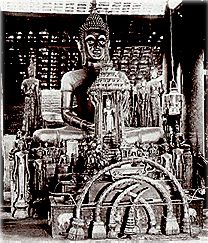It is undeniable that Khmer and Thai arts have had an
influence on Laotian sculpture, but Luang Prabang artists, for whom each Buddha image
possesses its own spirit, have sought to attain their goal by following a path which led
them to an elegant and spare stylisation. In its most highly idealized representation, the
image of the Buddha should have an egg-shaped head and face, eyebrows like a drawn bow, a
nose like the beak of an eagle and smooth, round arms like elephant tusks.However,
three major features characterize the Luang Prabang Buddha in comparison to those of the
neighboring countries. The usanisa (cranial protuberance) is always embellished with a
stylized flame; the ear-lobe unusually long is shaped like a snail shell; and the urna or
divine frontal sign is never represented.
Images of the Laotian Buddha, like all others in South East Asia, wear clothes:
the antaravasada wrapped around the hips and the uttarasanga draped in monastic style. The
sanghati folded and carried on the left shoulder, can seen on some Buddha statues.
The sitting Buddha, in the virasana in the maravijaya attitude has his left hand
resting on the lap; while the right hand, palm on knee, touches the pediment with the tips
of the fingers, thereby calling the earth as witness. Those in the samadhi attitude, both
hands resting in the lap, right hand on the left, are most often represented in Luang
Prabang.
The Buddha of Enlightenment, seated under a canopy of naga head protecting his
profound meditation is quite rare in Laos. The attitudes of the Standing Buddhas are more
varied. The Buddha may be standing still with a gesture of "Absence of Fear",
interpreted in Laos as being the ‘Buddha quietening family quarrels94. In the abdhaya
mudra attitudes, both palms are turned forward or if both arms are hanging beside the
body, it is considered to represent ‘Calling the rain over a Kingdom affected by
drought'. In some cases, the hands may be crossed on the stomach or carrying an alms bowl
with both hands in the attitude of the begging Buddha.
There is also a Buddha in a walking posture advancing on either foot. On the
side of the leading foot, the hand is lifted in the gesture of ‘Reassuring' or of
‘Increase'.
In Luang Prabang, wooden or bronze Buddha statues adorned with the finery of
Cakravatin monarchs, or even with the attributes of royalty on their monk92s robes are not
that common. And even rarer, since in Luang Prabang there is only a single statue at Vat
Xieng Thong dating from 1569, is a representation of the Buddha lying down.
The Luang Prabang Buddha has a profoundly moving effect by its grace, its
gentleness, the fluidity of line of its chest and thighs, the narrowness of its hips, the
elegance of its gestures and the slimness of its hands. It is covered with gold leaf by
the faithful, not so much to enrich the image, but to convey the color of the great sage's
skin endowed with a golden incarnation. It is therefore one of the most representative
elements of the traditional art of Luang Prabang which must, in our opinion, be protected
and preserved.

